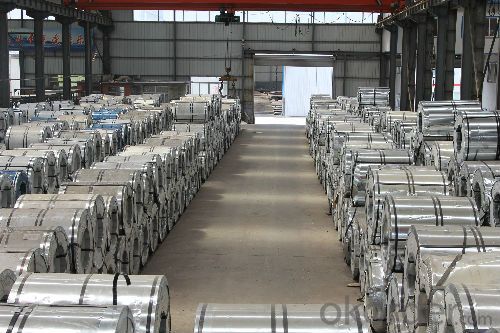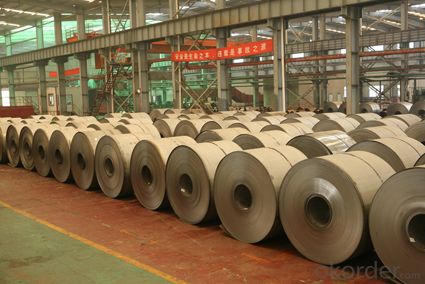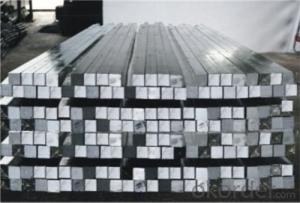14mm 12mm stainless steel wire rod wire rod
- Loading Port:
- Tianjin
- Payment Terms:
- TT or LC
- Min Order Qty:
- 25 m.t.
- Supply Capability:
- 10000 m.t./month
OKorder Service Pledge
OKorder Financial Service
You Might Also Like
Product Description:
OKorder is offering 14mm 12mm stainless steel wire rod wire rod at great prices with worldwide shipping. Our supplier is a world-class manufacturer of steel, with our products utilized the world over. OKorder annually supplies products to European, North American and Asian markets. We provide quotations within 24 hours of receiving an inquiry and guarantee competitive prices.
Product Applications:
14mm 12mm stainless steel wire rod wire rod are ideal for structural applications and are widely used in the construction of buildings and bridges, and the manufacturing, petrochemical, and transportation industries.
Product Advantages:
OKorder's 14mm 12mm stainless steel wire rod wire rod are durable, strong, and resist corrosion.
Main Product Features:
· Premium quality
· Prompt delivery & seaworthy packing (30 days after receiving deposit)
· Corrosion resistance
· Can be recycled and reused
· Mill test certification
· Professional Service
· Competitive pricing
Product Specifications:
square steel billet
1.3SP, 5SP
2.terms of payment: L/C at sight
3.size: 120*120mm
4.length: 5.8~12m
square steel billet
Specifications
square steel billets
1)We procure world class quality steel billets which meets the specific requirements of the clients
The Billets produced by the company can be broadly divided into three main types i.e.
M.S. Billets
CRS Billets
Special Alloy Billets
M.S. Billets are used for rolling of TMT Re-Bars of Fe415 and Fe500 Grade and various other structural steel products.
CRS Billets are used fro rolling of CRS TMT Re-Bars.
Special Alloy Billets are used for rolling of any special grade TMT Re-Bars like Earthquake resistant TMT Re-Bars and for special grade structural steel products.
The following are the sizes of Billets available with Shyam Steel Industries Ltd.:
100 X 100
120x120
150 X 150
Physical Properties:
Description
As per IS 2830
Shyam Billets
Bend (max.) 5 mm per meter >= 5 mm per meter
Carbon (max.) 3mm per meter >= 3 mm per meter
Length 3 mt - 13 mt 3 mt - 9 mt
Chemical Properties:
Ladle Analysis:
Designation
Carbon
Manganese
C15 0.12-0.18 0.30-0.60
C18 0.15-0.21 0.30-0.60
C20 0.17-0.23 0.30-0.60
C15 MMn 0.12-0.18 0.60-1.00
C18 MMn 0.15-0.21 0.60-1.00
C20 MMn 0.17-0.23 0.60-1.00
C15 HMn 0.12-0.18 1.00-1.50
C18 HMn 0.15-0.21 1.00-1.50
C20 HMn
0.17-0.23 1.00-1.50
Billets of different designations are manufactured in three different grades namely A, B, C having sulphur, phosphorous content (on ladle analysis) and carbon equivalent as follows:
Chemical Analysis:
Grade Sulphur Phosphorous Carbon Equivalent (CE)1
Max Max Max
A 0.05 0.05 0.42
B 0.045 0.045 0.41
C 0.04 0.04 0.39
FAQ:
Q1: How do we guarantee the quality of our products?
A1: We have established an advanced quality management system which conducts strict quality tests at every step, from raw materials to the final product. At the same time, we provide extensive follow-up service assurances as required.
Q2: What makes stainless steel stainless?
A2: Stainless steel must contain at least 10.5 % chromium. It is this element that reacts with the oxygen in the air to form a complex chrome-oxide surface layer that is invisible but strong enough to prevent further oxygen from "staining" (rusting) the surface. Higher levels of chromium and the addition of other alloying elements such as nickel and molybdenum enhance this surface layer and improve the corrosion resistance of the stainless material.



- Q:Can a steel square be used for post layout and construction?
- Yes, a steel square can be used for post layout and construction. Steel squares are versatile tools that can be used for measuring and marking angles, checking right angles, and laying out posts or other structural elements accurately. They are commonly used in carpentry, framing, and other construction applications.
- Q:How do you use a steel square to determine the length of a roof ridge?
- To determine the length of a roof ridge using a steel square, you would first mark a point on one end of the ridge. Then, place the steel square with one leg against the marked point and align the other leg with the ridge. Keeping the square firmly against the ridge, walk along the length of the ridge while constantly checking that the square is aligned. Once you reach the other end of the ridge, mark the point where the square aligns with the ridge. The distance between the two marked points will give you the length of the roof ridge.
- Q:How do you use a steel square to measure and mark parallel lines?
- To measure and mark parallel lines using a steel square, adhere to the following steps: 1. Position the steel square onto the material's edge where the lines will be marked. Verify that the long side of the square aligns with the edge of the material. 2. Securely hold the square in place, making certain that it remains immobile and does not shift throughout the process. 3. Take a pencil or marking tool and glide it along the square's shorter side, creating a line on the material that runs parallel to the edge. 4. Repeat this process at various points along the edge, marking multiple parallel lines as necessary. By consistently aligning the steel square with the edge and gliding the marking tool along its shorter side, you can guarantee that the lines you mark will be parallel to the material's edge. This technique proves beneficial in various trades, including carpentry, woodworking, metalworking, and other disciplines that demand precise and parallel lines.
- Q:Can a steel square be used for measuring angles in metal roofing?
- Yes, a steel square can be used for measuring angles in metal roofing. Steel squares have a built-in protractor that allows for accurate angle measurements, making them a suitable tool for measuring and marking angles in metal roofing projects.
- Q:Can a steel square be used for measuring the depth of a well?
- No, it is not possible to use a steel square for the purpose of measuring the depth of a well. A steel square, which is alternatively called a try square or a framing square, is primarily utilized in carpentry and woodworking for the purpose of measuring and marking right angles. It comprises a long steel blade that is connected to a handle at one end, forming the shape of an "L". When it comes to measuring the depth of a well, a different type of tool known as a well depth indicator or well sounder is required. This tool generally consists of a lengthy and narrow metal tape or cable that possesses markings to indicate the depth. It is specifically designed to accurately measure the depth of water present in a well or borehole. Using a steel square to measure the depth of a well would not yield precise or dependable results. It is crucial to make use of the appropriate tools that are specifically designed for the purpose of well depth measurement in order to ensure accurate readings and proper management of the well.
- Q:Can a steel square be used for measuring and marking compound bevel and miter cuts?
- Yes, a steel square can be used for measuring and marking compound bevel and miter cuts. It is a versatile tool that can help in accurately measuring and marking angles for various woodworking and metalworking tasks.
- Q:Can a steel square be used for checking the squareness of door frames?
- The squareness of door frames can be checked using a steel square. A steel square, also called a framing square, is a carpentry and woodworking tool frequently employed to verify the accuracy and squareness of different angles and joints. It consists of two arms, usually made of steel, that form a right angle. One arm is longer and known as the blade, while the other arm is shorter and referred to as the tongue. To check if a door frame is square using a steel square, position the longer blade against the inside corner of the frame where the door will be installed. Then, extend the shorter tongue along the inside edge of the door frame. By visually examining the alignment between the door frame and the steel square, you can determine if it is perfectly square or if adjustments are necessary. A door frame that is not square can lead to difficulties during door installation, such as problems with opening and closing, gaps between the door and the frame, or uneven wear on the door over time. By utilizing a steel square, you can ensure that the door frame is properly aligned and square prior to installing the door, resulting in a smooth and functional operation.
- Q:How do you use a steel square to determine the angle of a roundover cut?
- To use a steel square to determine the angle of a roundover cut, you can follow these steps: 1. Start by placing the steel square against the edge of the workpiece where you want to make the roundover cut. Ensure that the square is aligned perpendicular to the edge. 2. Next, locate the corner of the square that aligns with the edge of the workpiece. This will be the reference point for measuring the angle. 3. Take a protractor and place it on top of the steel square, ensuring that its center aligns with the reference corner. 4. Now, observe the angle measurement on the protractor where the edge of the workpiece intersects it. This will give you the angle of the roundover cut. 5. Once you have determined the angle, you can transfer it to your woodworking tool, such as a router or table saw, to set the appropriate cutting angle. Remember, it is crucial to double-check your measurements and alignment before making any cuts to ensure accuracy. Additionally, practice caution and follow proper safety procedures while working with power tools.
- Q:What are the different techniques for using a steel square in woodworking joinery?
- There are several techniques for using a steel square in woodworking joinery, each serving a specific purpose in achieving accurate and precise measurements and angles. Here are a few commonly used techniques: 1. Checking for squareness: One of the primary uses of a steel square is to ensure that the corners of a joint or workpiece are perfectly square. To do this, you can place the square against the edge of the workpiece and check if the adjoining edge is perpendicular to it. This technique is crucial for creating strong and stable joints. 2. Marking 90-degree angles: When you need to mark a 90-degree angle on a workpiece, a steel square comes in handy. Place the square against the edge of the workpiece and trace along the inside edge of the square with a pencil or marking knife. This technique ensures consistent and accurate marking for precise joinery. 3. Marking angles other than 90 degrees: Steel squares often come with additional markings that allow for the measurement and marking of angles other than 90 degrees. By aligning the desired angle measurement with the edge of the workpiece, you can accurately mark the angle needed for complex joinery. 4. Determining plumb and level: Steel squares can be used to check if a workpiece is plumb (vertical) or level (horizontal). By holding the square against the edge of the workpiece and using a spirit level or plumb bob, you can ensure that your project is properly aligned. 5. Transferring measurements: Steel squares can also be used to transfer measurements from one workpiece to another. By aligning the square against the edge of the first workpiece and marking the desired measurement, you can then transfer that measurement to the second workpiece using the square as a guide. 6. Creating mitered corners: When working with mitered corners, a steel square is essential for ensuring accurate angles. By placing the square against the workpiece and aligning it with the desired angle, you can mark and cut the joint precisely, resulting in clean and tight mitered corners. In summary, the steel square is a versatile and valuable tool for woodworking joinery. Whether you need to check for squareness, mark angles, determine plumb and level, transfer measurements, or create mitered corners, the steel square provides the precision and accuracy required for successful woodworking projects.
- Q:How do you use a steel square for marking and cutting angled bridle joints?
- Achieving accurate and precise results when marking and cutting angled bridle joints can be done by using a steel square. The following steps outline the process: 1. Familiarize yourself with the concept: Bridle joints are woodworking joints where two pieces of wood intersect at a right angle. Each piece's ends are cut at a 45-degree angle, forming a V-shaped notch. The steel square assists in ensuring precise markings and cuts for this joint. 2. Mark the wood: Begin by measuring and marking the desired length of the joint on each piece of wood. Utilize a measuring tape and pencil for precise markings. 3. Position the steel square: Place the steel square on one end of a wood piece, aligning it with the edge. Ensure that the 45-degree angle is inward, facing the center of the wood. 4. Mark the angles: Trace the inside of the steel square along the 45-degree angle using a pencil or marking knife. This will create a straight and accurate line representing the angled cut to be made. 5. Repeat on the other piece: Flip the steel square and repeat the marking process on the second wood piece's end. Ensure that the angles align perfectly when the two pieces are joined. 6. Cut the joint: Once the marks are made, use a saw to cut along the marked lines on each wood piece. Take your time and make precise cuts to achieve a clean joint. 7. Test the fit: After cutting both pieces, test their fit by joining them together. The angled cuts should result in a tight and secure joint. Make any necessary adjustments if the fit is not ideal. By employing a steel square to mark and cut angled bridle joints, you can attain precise and accurate outcomes, ensuring a visually appealing and robust joint in your woodworking project.
1. Manufacturer Overview |
|
|---|---|
| Location | |
| Year Established | |
| Annual Output Value | |
| Main Markets | |
| Company Certifications | |
2. Manufacturer Certificates |
|
|---|---|
| a) Certification Name | |
| Range | |
| Reference | |
| Validity Period | |
3. Manufacturer Capability |
|
|---|---|
| a)Trade Capacity | |
| Nearest Port | |
| Export Percentage | |
| No.of Employees in Trade Department | |
| Language Spoken: | |
| b)Factory Information | |
| Factory Size: | |
| No. of Production Lines | |
| Contract Manufacturing | |
| Product Price Range | |
Send your message to us
14mm 12mm stainless steel wire rod wire rod
- Loading Port:
- Tianjin
- Payment Terms:
- TT or LC
- Min Order Qty:
- 25 m.t.
- Supply Capability:
- 10000 m.t./month
OKorder Service Pledge
OKorder Financial Service
Similar products
New products
Hot products
Related keywords


























